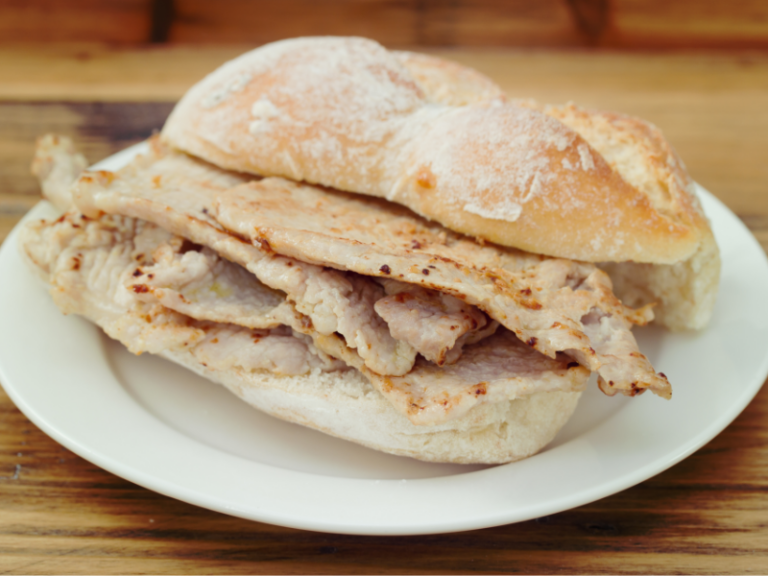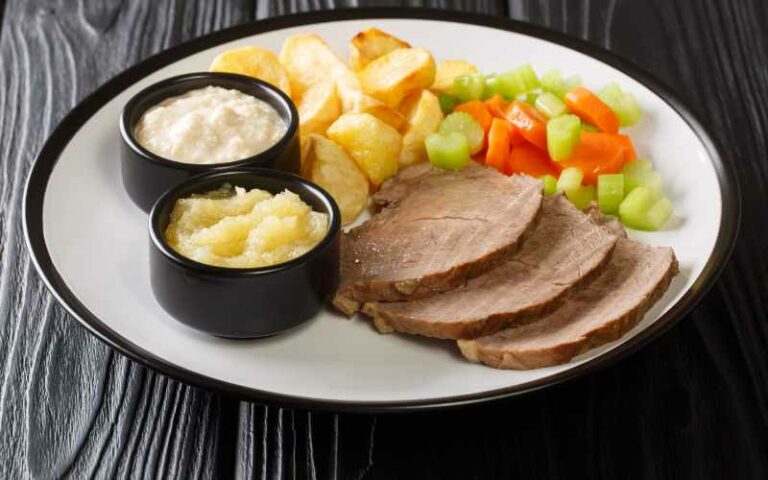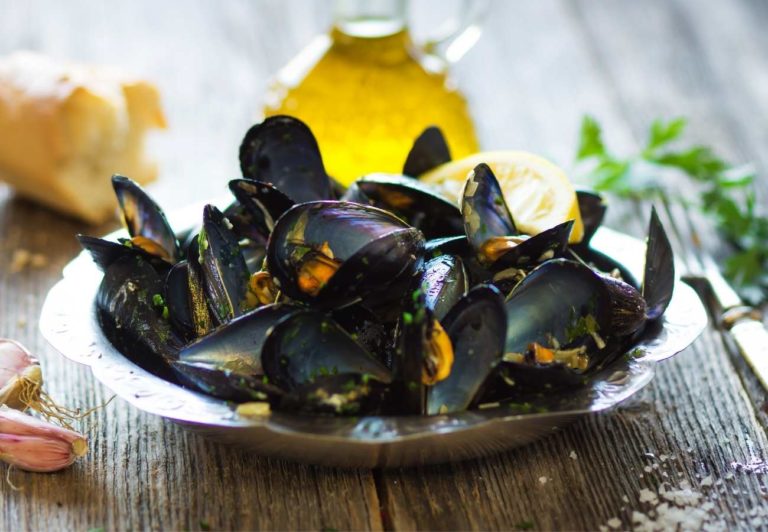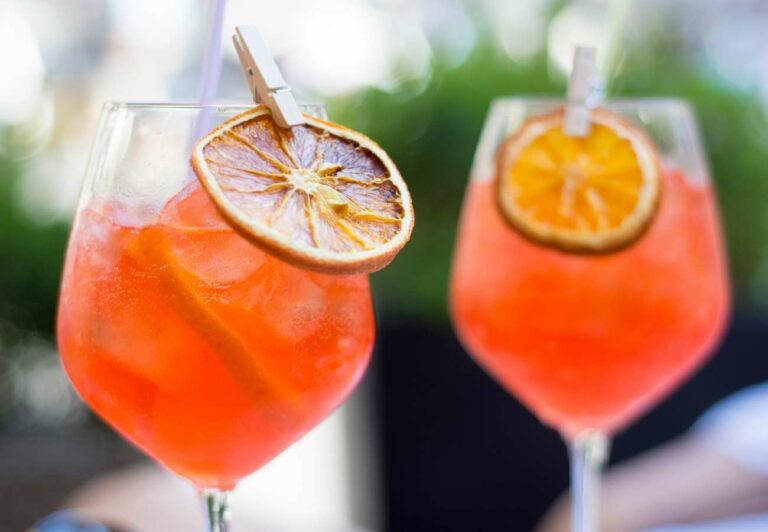Spanish Food: 33 Traditional Dishes of Spain
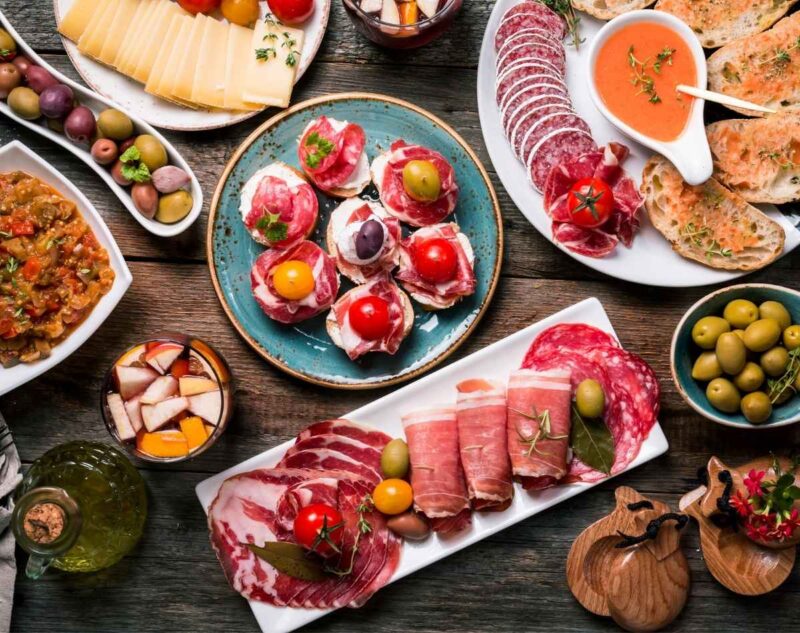
Spanish cuisine has been heavily influenced by the country’s history, geography, culture and climate.
For instance, the vast amount of seafood available from the seas surrounding Spain are included in many traditional dishes, particularly in coastal regions, such as Catalonia and Andalusia.
Two staple ingredients in almost all Spanish foods are olive oil and garlic. Typical herbs used in Spanish food include oregano, parsley and thyme.
Tapas, small dishes typically enjoyed as appetizers or snacks, is a famous Spanish cuisine served in bars and restaurants around the world. The name ‘tapas’ comes from the Spanish word ‘tapar’, which means ‘to cover’. Originally tapas were simple slices of bread or meat used to cover glasses of wine, which prevented flies from getting in.
Tapas often consists of cured hams, cheeses, olives, seafood and bread, as well as hot foods such as calamari.
Salmorejo (Tomato and Bread Soup)
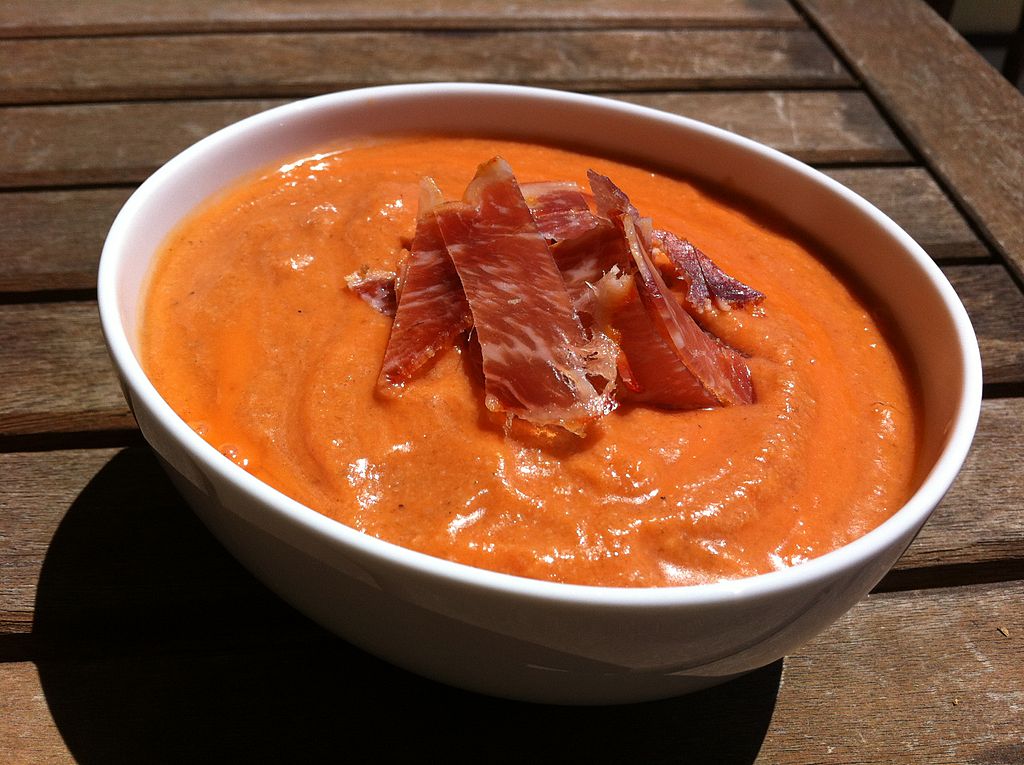
Salmorejo is a cold soup from the south of Spain, made with tomatoes and bread, and topped with chunks of boiled eggs and pieces of jamon iberico.
This soup bears a close resemblance to Gazpacho, but is usually bright orange in color and with a thicker texture due to the bread involved. Salmorejo is found in many Spanish restaurants or tapas bars as a sauce, and is often used to prepare montaditos (open-faced sandwiches).
Sherry vinegar, known as jerez vinegar in Spain, and olive oil are added to the soup to alter the acidity and enhance the flavors.
Rabo de Toro (Ox Tail Stew)
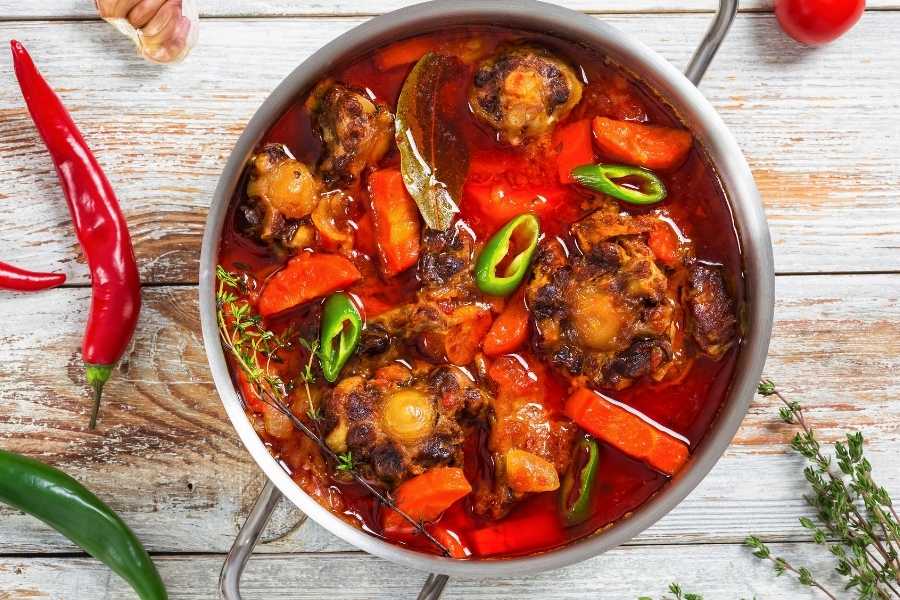
Rabo de Toro is a dish consisting of stewed ox tail which is cooked for several hours in a red wine and tomato stock mixture.
Traditionally, Rabo de Toro was made out of the tails of fighting bulls – a male cow who had succumbed to a bull fight. Today, is more popularly made with ox tail.
Coquinas (Clams)
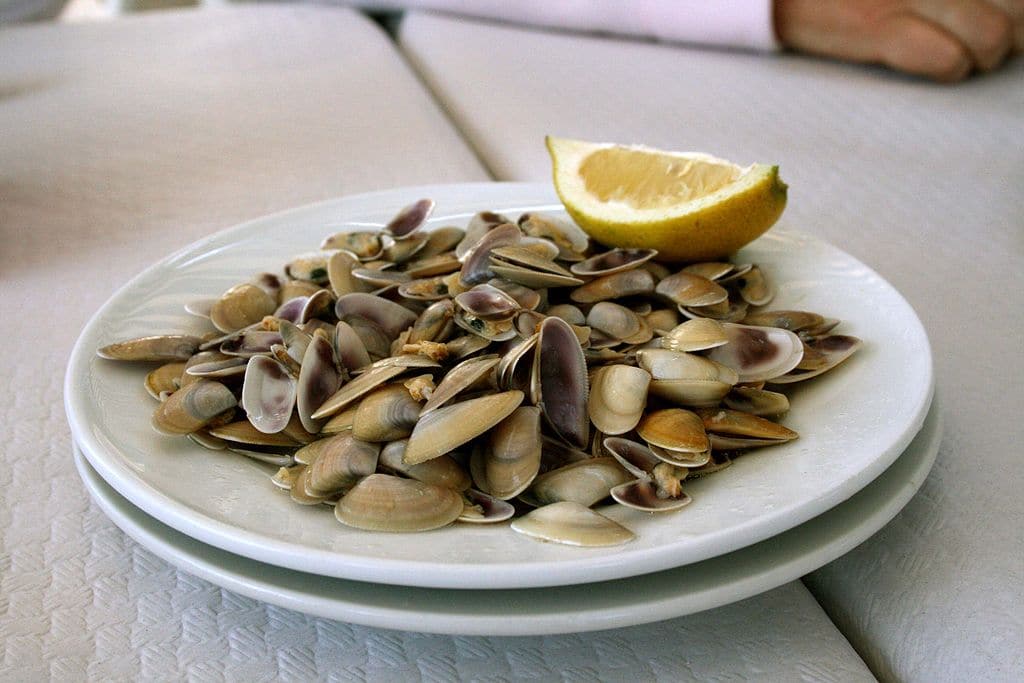
Coquinas are small clams collected from the coast of Andalucia, often cooked with olive oil, lemon, parsley and garlic until they open up and the meat can be removed from the shells.
The leftover sauce from this dish is also used as a dip for bread, which is usually served as a side dish.
Espinacas Con Garbanzos (Spinach and Chickpea Stew)
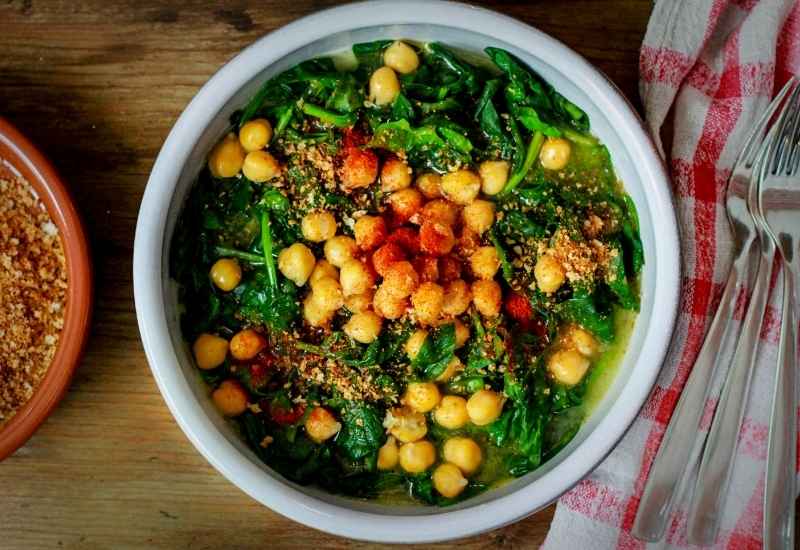
Espinacas con garbanzos is a stew made by frying chickpeas (garbanzo beans), spinach, garlic and bread, and boiling with spices such as cumin and pimenton.
This dish is originally from Seville and is usually served as a tapas dish, with bread to soak up the leftover sauce. The exact recipe and spice blend varies slightly between chef and region of Spain.
Crema Catalana (Custard Dessert)
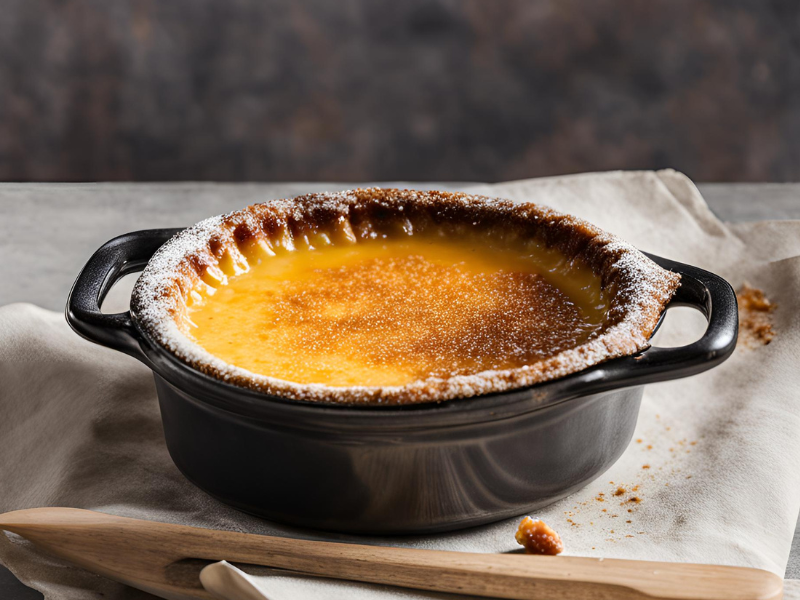
Crema Catalana is a dessert made with custard topped with a layer of caramelized sugar. Hailing from Cataluna, Crema Catalana is a similar dish to a créme brûlée.
This dessert is served cold, and its custard is usually infused with lemon rind and cinnamon.
Crema Catalana uses milk instead of heavy cream, making it lighter and more delicate than its French counterpart.
Queso Manchego (Sheep’s Cheese)
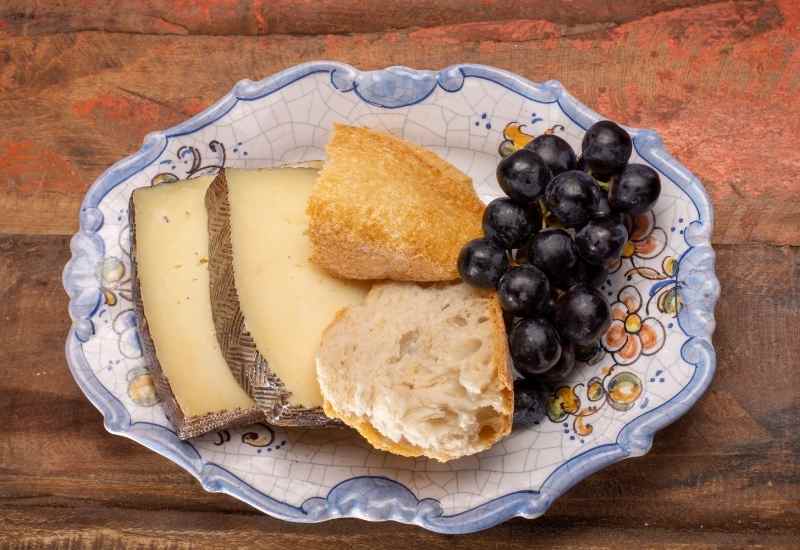
Queso Manchego is a cheese made from sheep milk; traditionally Manchego cheese is only made in the La Mancha region from a specific sheep breed called ‘Manchega’.
This sheep’s cheese is aged between 60 days and 2 years; it has a firm consistency and creamy, buttery texture.
Leche Frita (Deep Fried Custard)
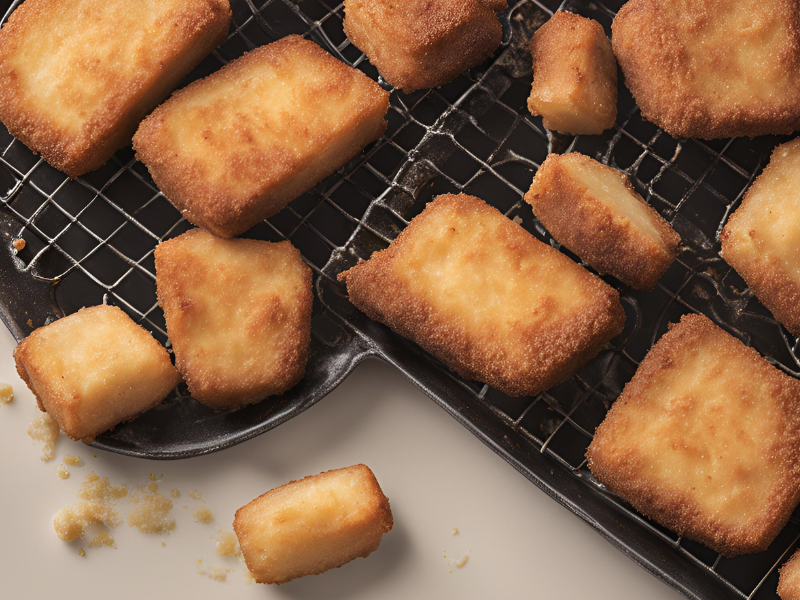
Leche Frita is a fried custard dessert, made by cooking milk, sugar and flour until it turns into a dough which is then fried and covered with a sugar glaze and cinnamon powder.
This is a popular sweet snack or dessert in Spain, often paired with a scoop of vanilla ice-cream and a cup of black coffee.
Fabada (Bean Stew)
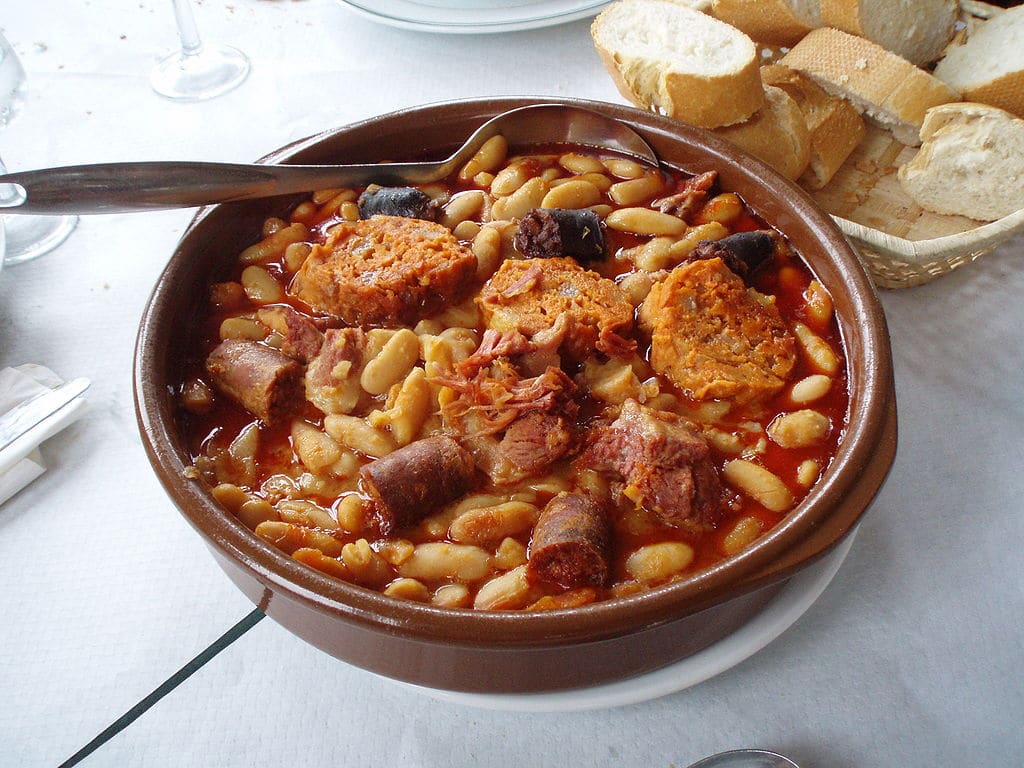
Fabada is a bean stew made by slow cooking white beans with black pudding, pork shoulder, saffron and chorizo. It is often cooked and served in a traditional clay oven which gives the stew an additional smoky flavor.
This stew originated from the northwest Asturia region and consists of Spanish white beans (faba asturiana). Fabada is very popular during the winter months, where it is served with a crusty bread to soak up the broth.
Pisto Manchego (Cooked Vegetables and Tomato)
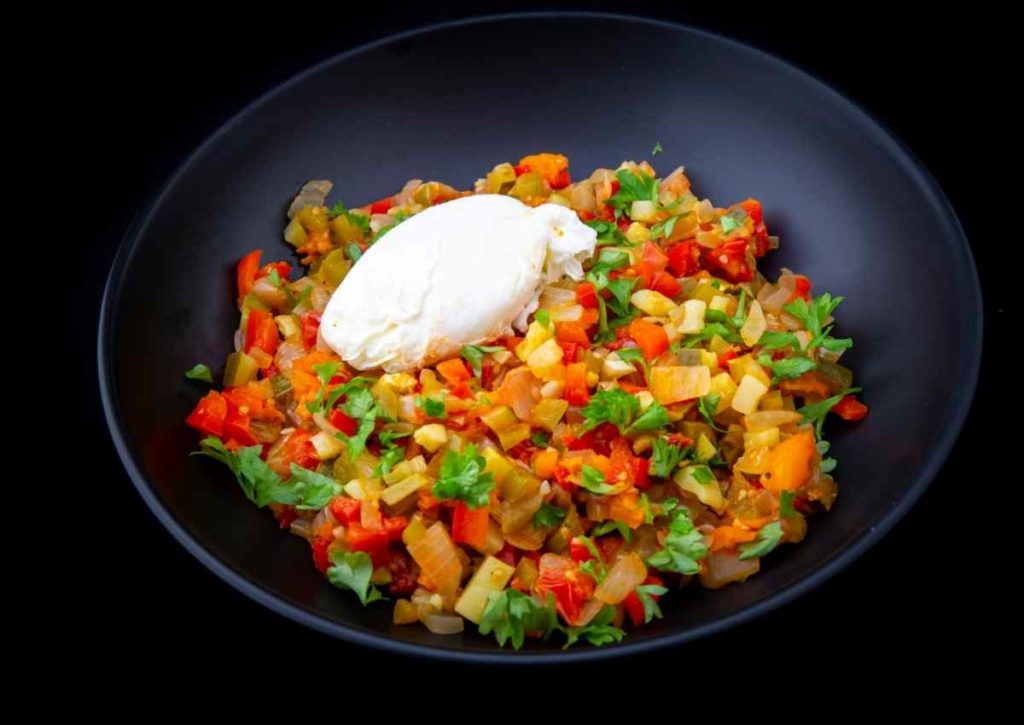
Pisto Manchego is a vegetarian dish made with tomatoes, onions, eggplant or courgettes, and bell peppers, and topped with a fried egg.
This vegetable dish is often served as a starter or an accompaniment to meat or fish, and is served with bread. The French have a similar dish which is known as ratatouille.
Churros (Fried Dough)
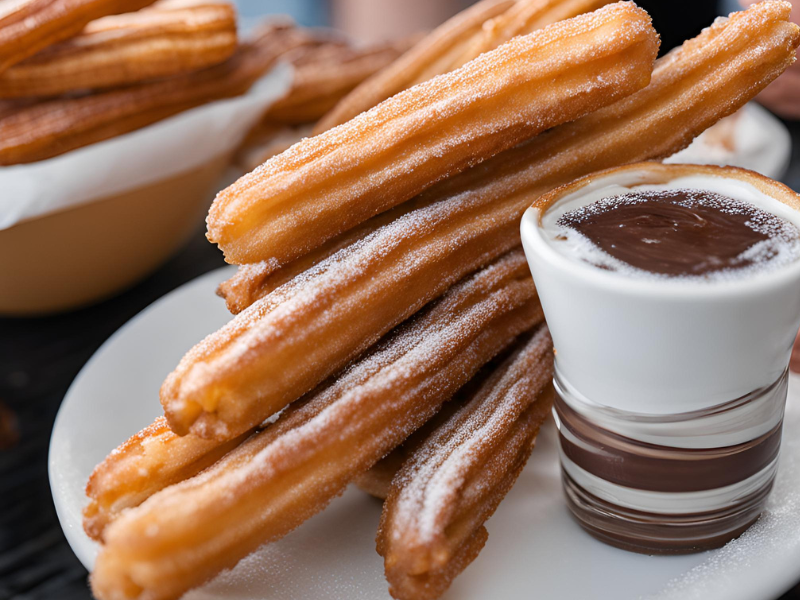
Churros are long strips of choux pastry dough that are deep fried and covered in cinnamon sugar, with a similar texture to donuts.
These can be found across Spain as a popular dessert, and as a snack, often served with a cup of melted chocolate sauce to dip the churros into.
Patatas Bravas (Potatoes)
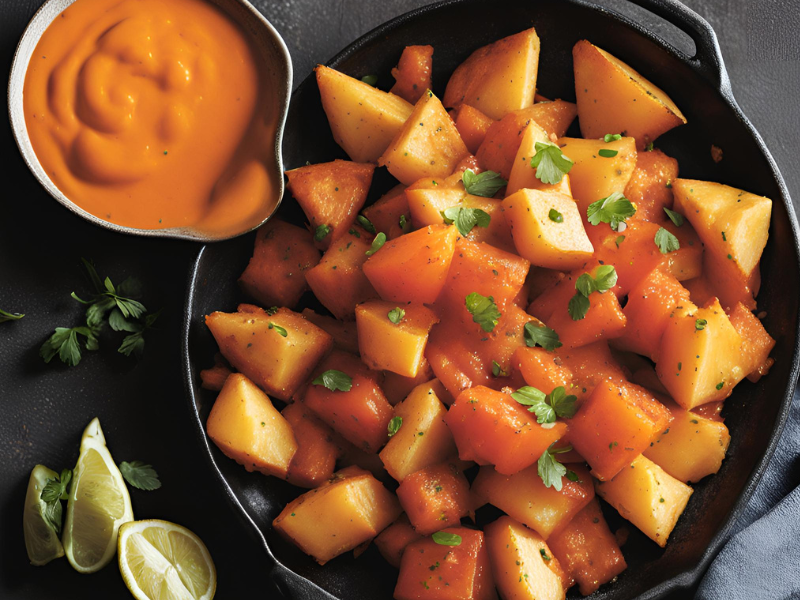
Patatas Bravas are made with white potatoes that have been cut into cubes, then fried in oil and served warm with a spicy brava sauce. The brava saucevfv is a spicy condiment made with
This is a popular tapas dish served at restaurants and bars throughout Spain.
Morcilla (Blood Sausage)
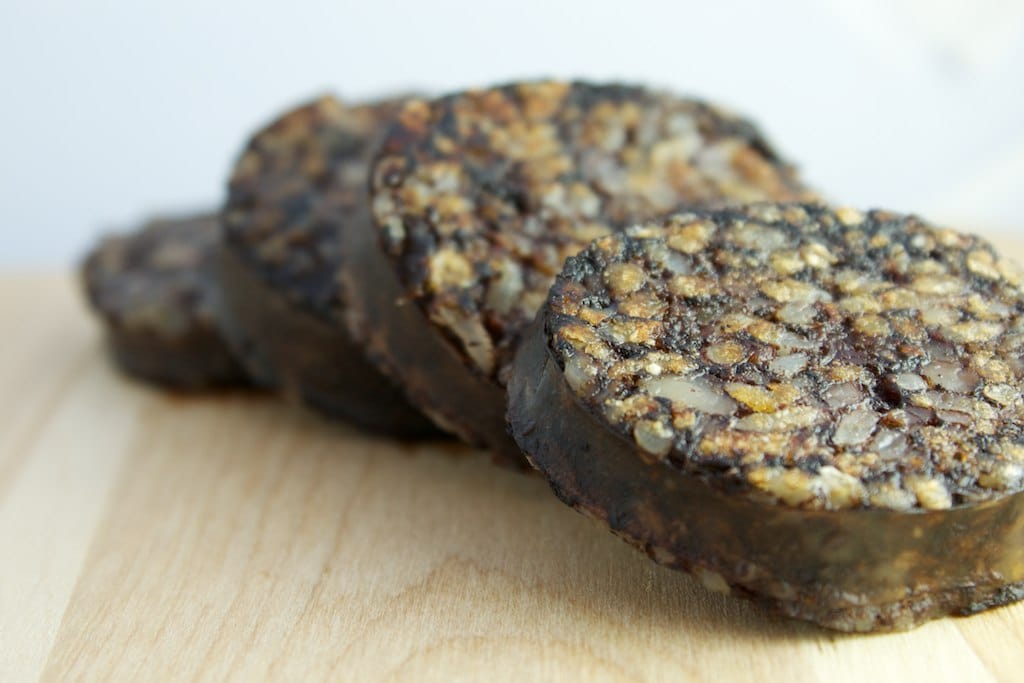
Morcilla is a blood sausage, traditionally made with rice or onions, pine nuts, paprika and almonds. The sausage is fried in olive oil and served with a crusty bread, it can also be paired with flavor stews such as the above mentioned fabada.
Similar blood sausages can be found in other countries, such as British black pudding, German Blutwurst and French boudin noir.
Cazon En Adobo (Deep Fried Dogfish)
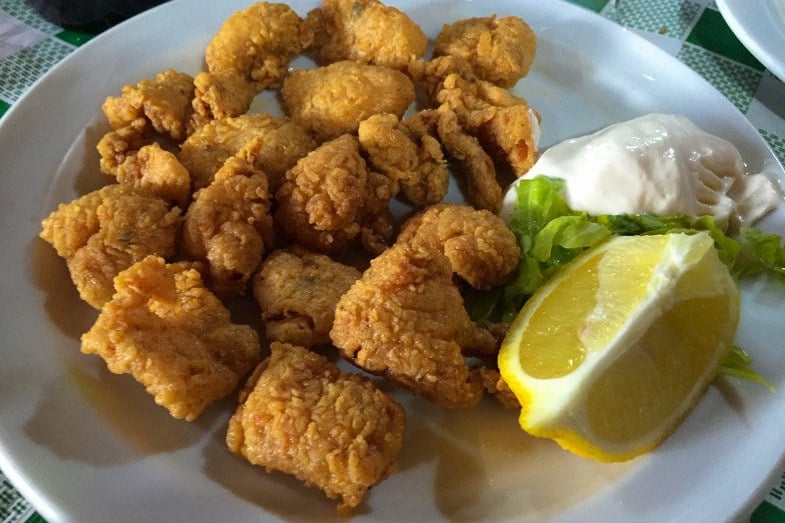
Cazon En Adobo is made by marinading Cazon, which is a small shark known as dogfish, with acidic vinegar juice and deep-frying in batter.
Adobo is a generic term referring to the marinade rich in spices, oil and vinegar which is used to enhance the flavor and preservation of food across much of South America and the Iberian peninsula.
Adobo serves as the tenderising agent and softens the meat which is then cut into chunks, battered and deep fried.
Paella
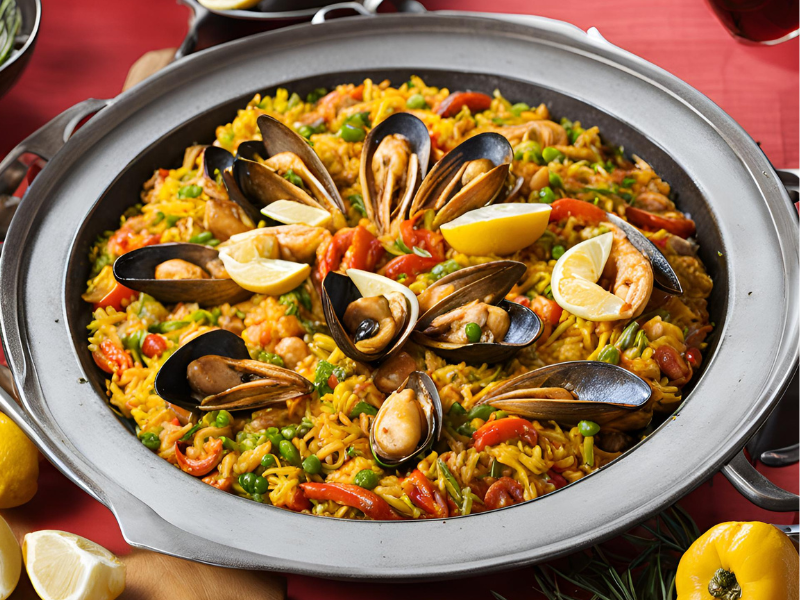
Paella is rice dish made by slowly cooking round-grain rice with seafood, meat and vegetables in broth in a wide, shallow traditional pan over a fire. This dish has a distinctive yellow color due to the addition of saffron.
This world-famous Spanish dish is originally from the Valencia, today it is found in restaurants and households around the world. The name paella comes from the Valencian word for a frying pan.
Fideua
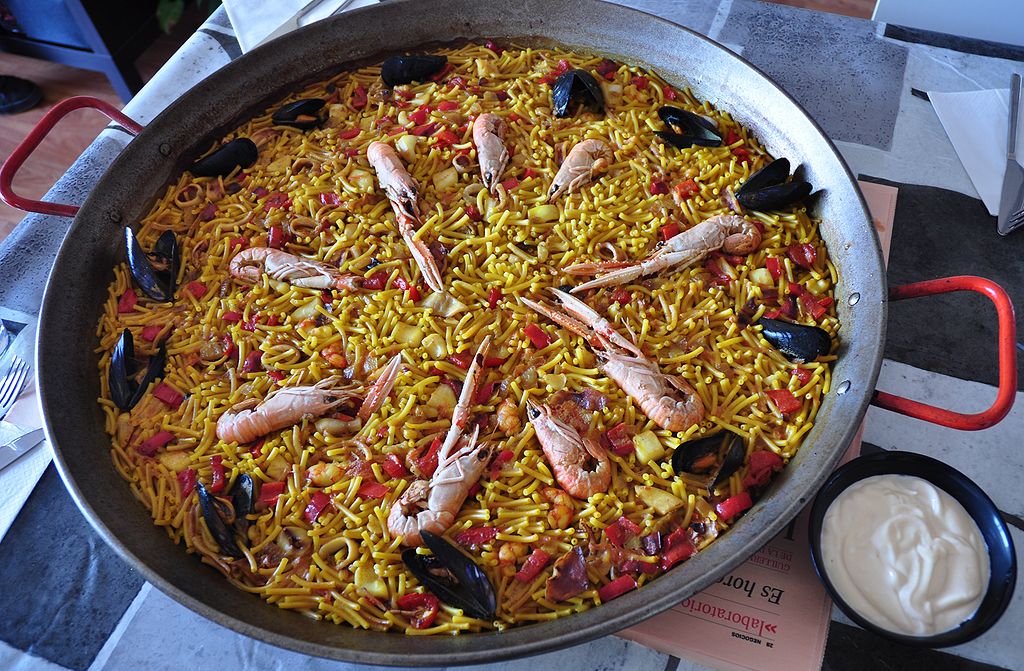
Originating from the North-Eastern part of Spain, Valencia, Fideua is a close relative to paella, but instead of the rice used in paella, it is made with a special noodle known as fideua.
The method for making Fideua is quite similar to paella, with rich fish stock and morsels such as clams, monkfish and prawns cooked together in a large, shallow pan.
Although paella might be more internationally famous, fideuada is the more popular choice for locals in the north-eastern region of Spain.
Pepito
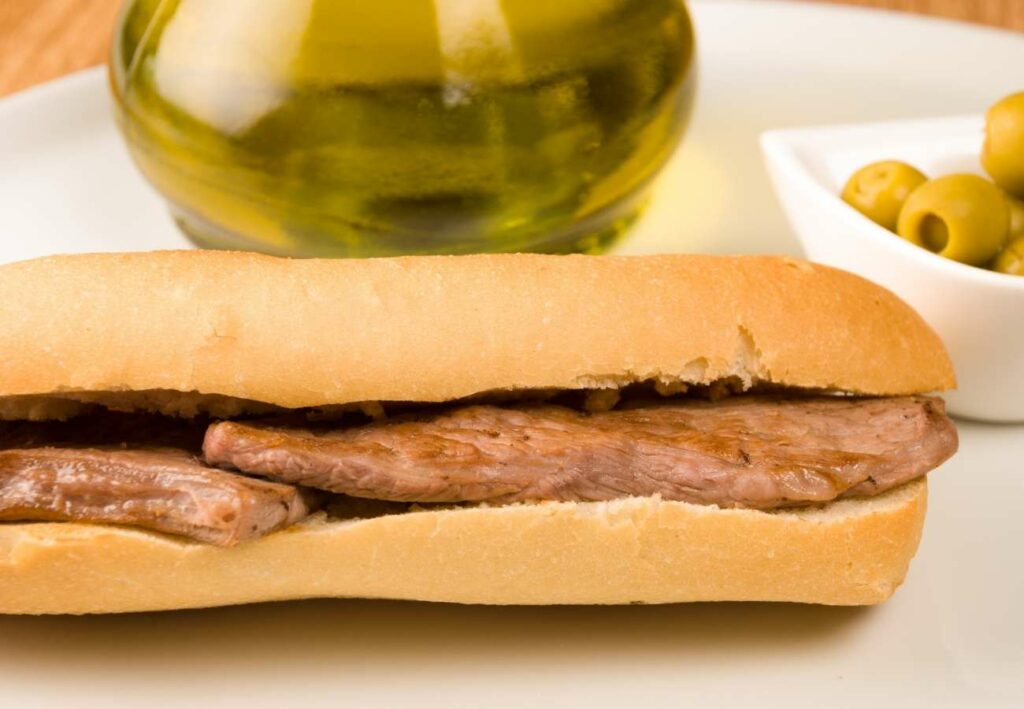
Pepito is a traditional sandwich made with beef, pork or chicken. Additional ingredients used to prepare this sandwich include refried beans, black beans or pinto beans. The bread can be a soft roll, bun or baguette.
This sandwich is also consumed throughout Latin America, for instance in Venezuela and in Mexico.
The ingredients of Pepito may vary by region and by people’s preferences, extra ingredients that can be added to the sandwich includes eggs, onions, cheese, lettuce and avocado.
Papas Arrugadas With Mojo (Potatoes with Red Pepper Sauce)
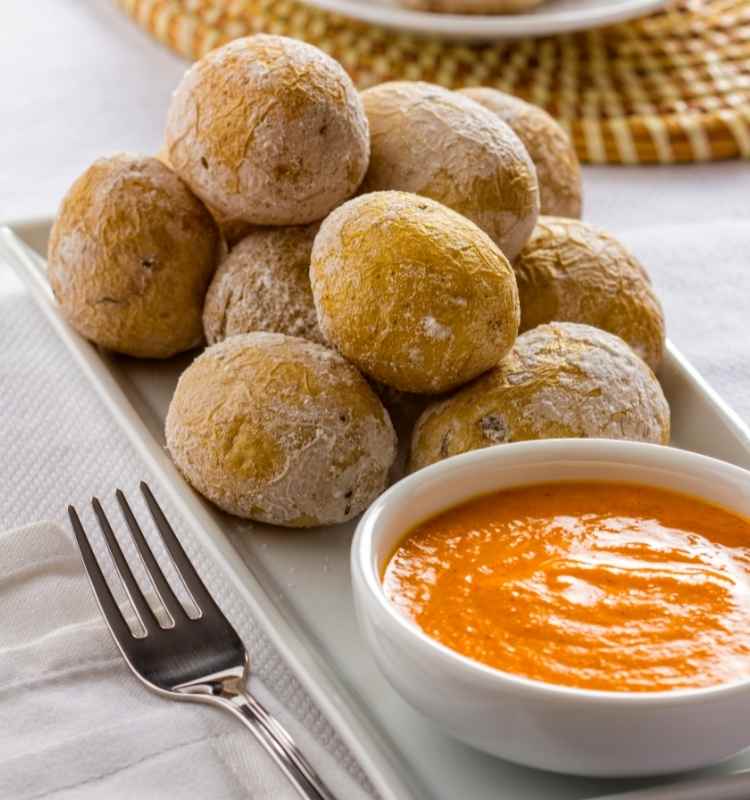
Originally from the Canary Islands, Papas Arrugadas With Mojo are small potatoes that are boiled in salt water and baked until their skin shrivels, which are then served with a dollop of Canarian mojo – a sauce made with red peppers and spices which give the dish its warmth and rich flavor.
This dish is similar to another Spanish dish called patatas bravas, which are essentially fried potato chunks topped with a spicy red sauce.
Bocadillo (Chorizo Sandwich)
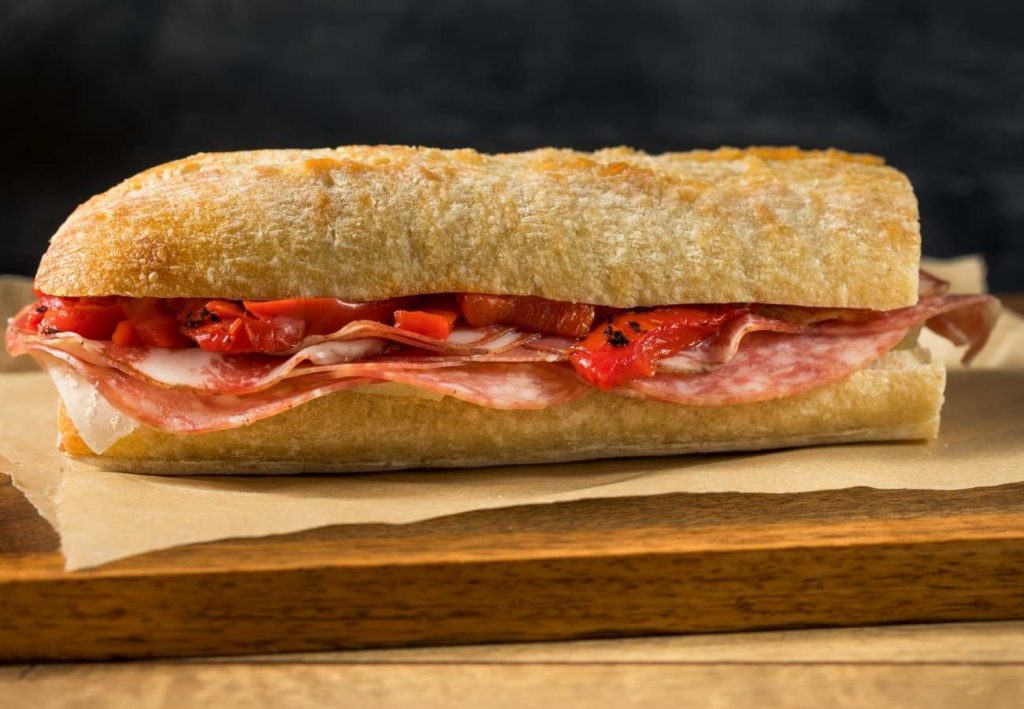
Bocadillo, also known as bocata, is a sub-type sandwich prepared using Spanish bread, usually a baguette, cut lengthwise and filled with slices of pickled green (or red) peppers, chorizo, slices of pork loin, tomatoes, sliced Manchego cheese, and some olive oil.
Pulpo a la Gallega (Boiled Octopus)
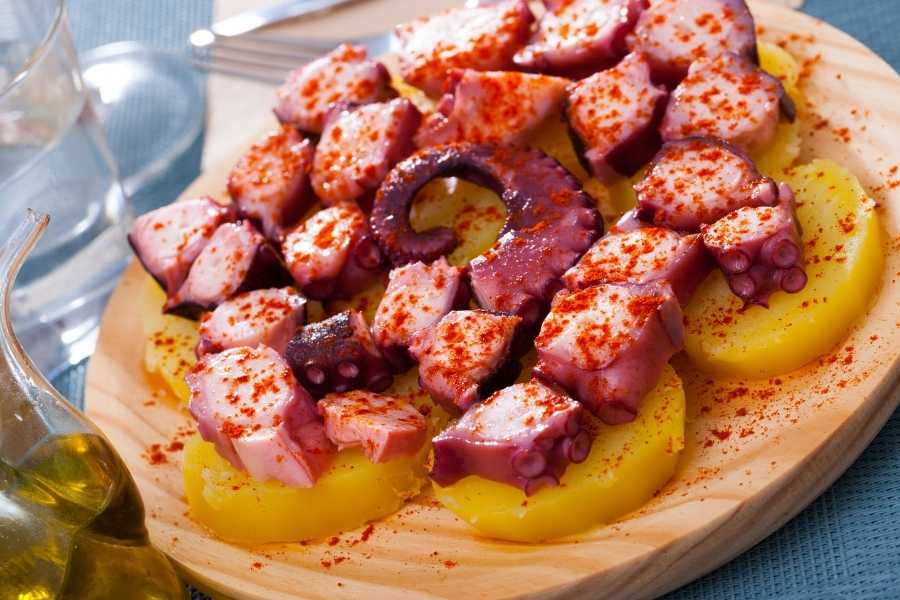
Pulpo a la Gallega is an octopus dish which originates from the Galicia region of Spain; the octopus is boiled, sliced and then drizzled with oil and paprika.
Pulpo a la Gallega is often served over sliced potatoes.
Puchero (Stew)
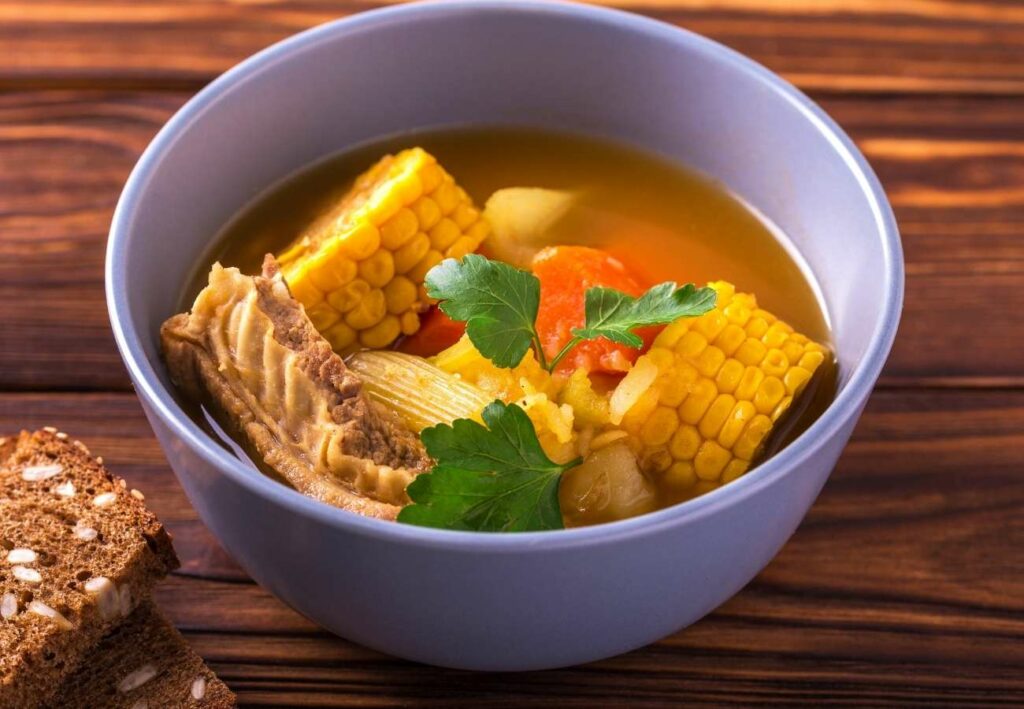
Puchero is a stew consisting of meats and a wide range of local vegetables, the exact ingredients of which vary by region.
Chickpeas are commonly added to this stew in Spain, as well as harder root-type vegetables, including potatoes, carrots, turnips, several greens and corn.
The Spanish term puchero originally referred to an earthenware pot, and later the word was used to describe the food prepared in it.
The dish is also very popular in Mexico, Argentina, Paraguay and Uruguay.
Angulas (Baby Eels)
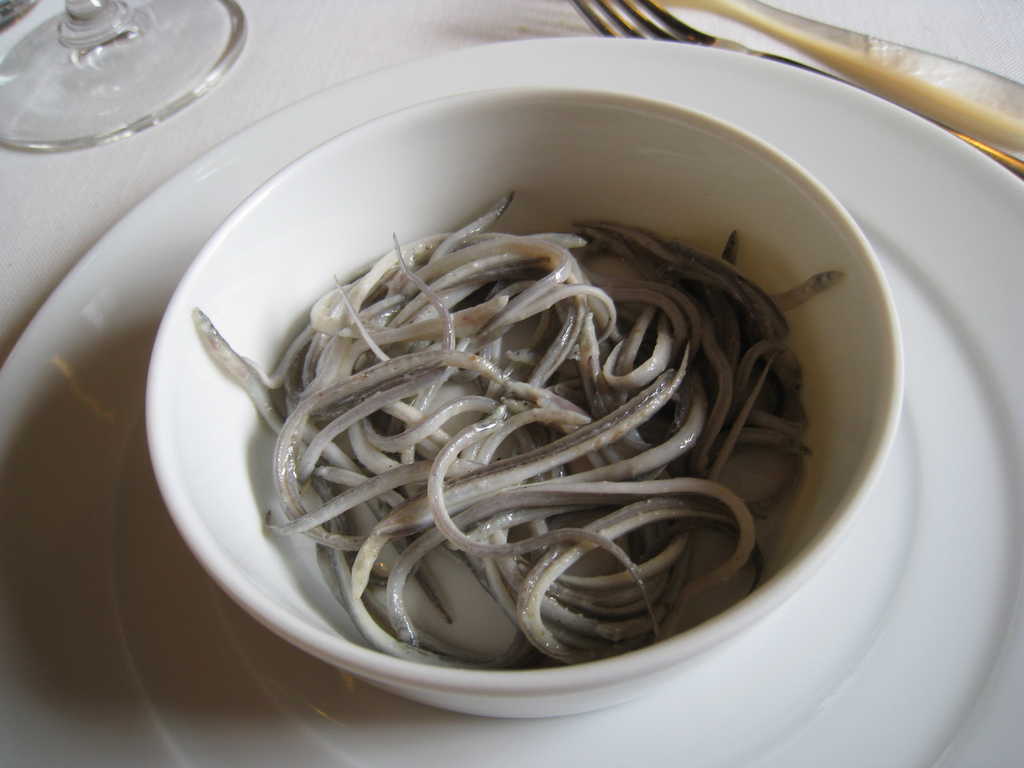
Angulas are baby eels, which are popular in the Basque region of Spain.
Considered to be one of Spain’s most expensive foods, they are generally consumed tapas-style, as an element of a multi-course meal or with spaghetti.
Baby eels were traditionally cooked and consumed individually in a small dish along with a unique wooden fork prepared using Boj wood.
Tarta de Santiago (Almond Cake)
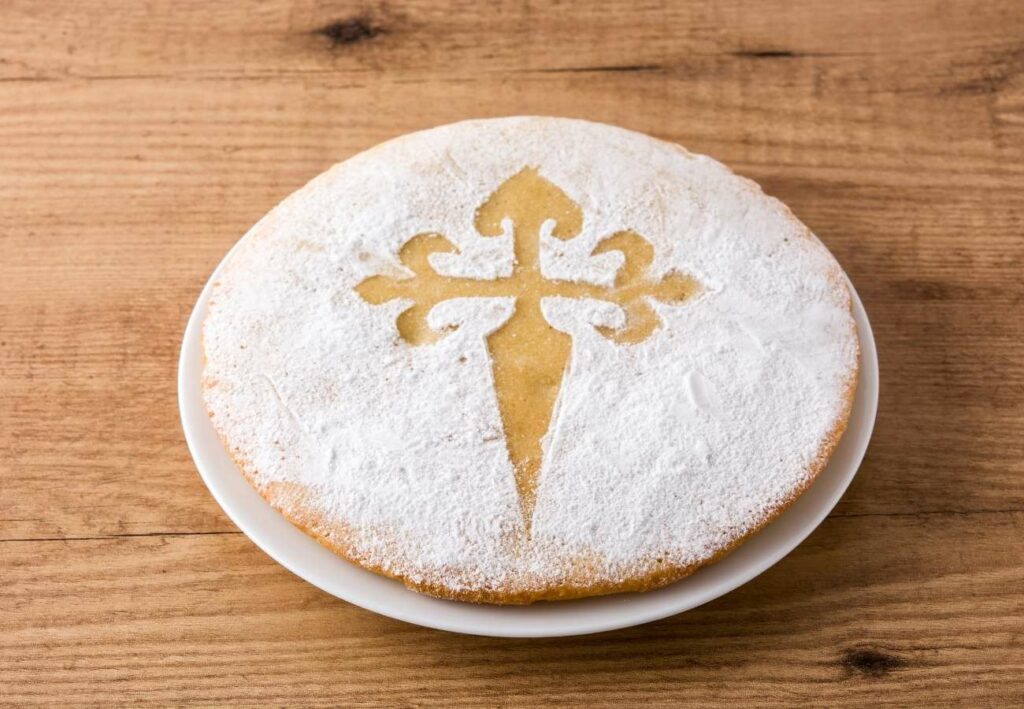
Tarta de Santiago is a Spanish almond cake or pie, made with ground almonds, eggs and sugar. The cake is flavored with lemon zest, sweet wine, brandy or grape marc, depending on the recipe.
Torrejas (Sweet Fried Bread)
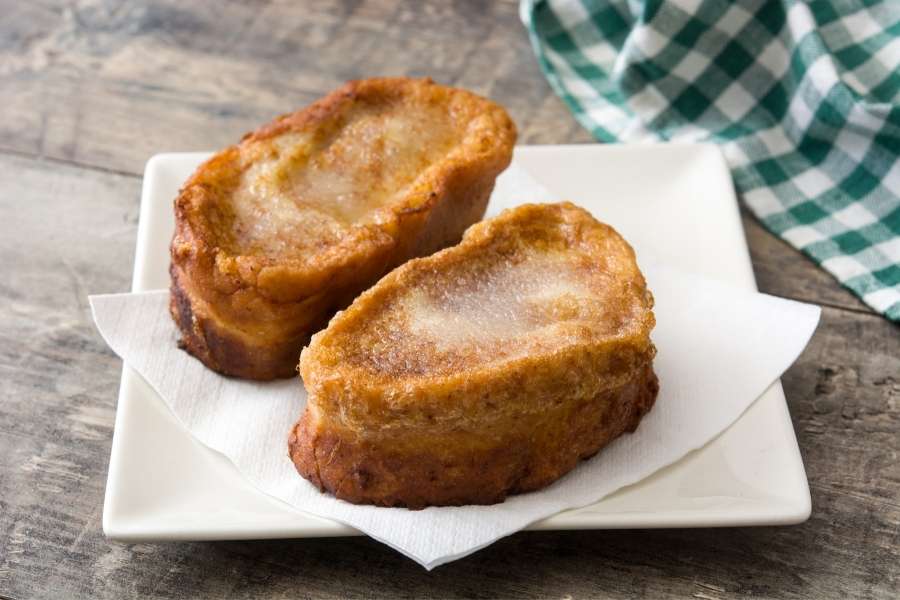
Torrejas are a traditional dessert eaten in many Latin American countries such as including Mexico and El Salvador, made from bread which is dipped in eggs before being fried and soaked in a sweet syrup.
This dish is similar to French toast or eggy bread which is prepared in a similar fashion.
Rosquillas (Donuts)
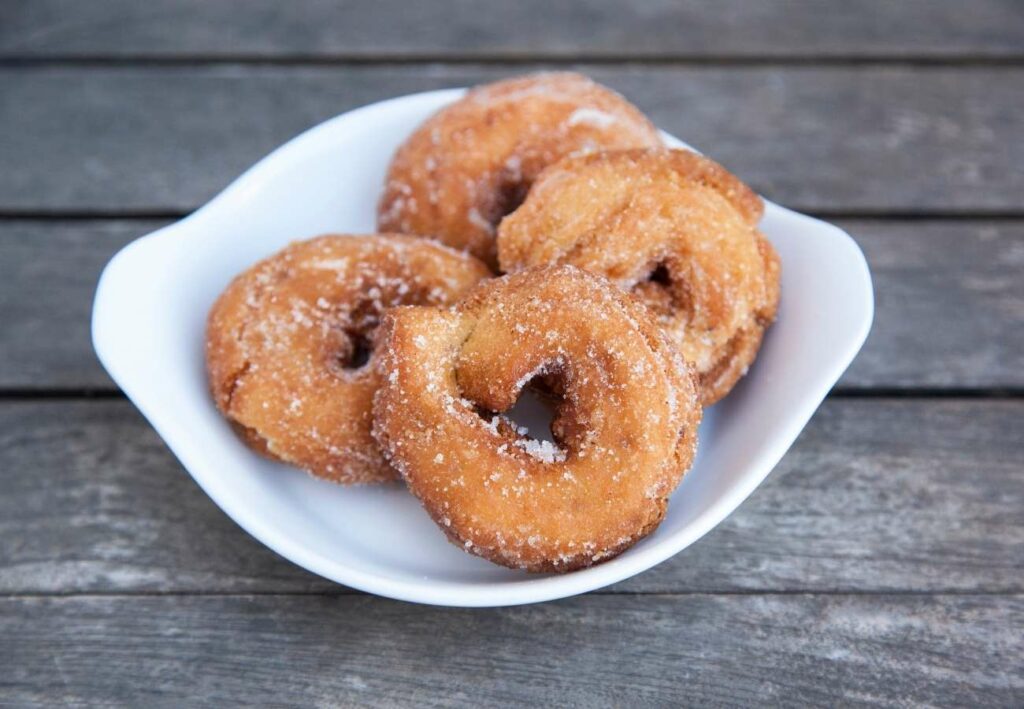
Rosquillas are crown-shaped, deep-fried donuts. They are comparatively smaller in size to regular donuts, fluffy in texture, and consist of a hole in the center.
They are generally made during the Holy Week festivities in Spain.
Croquetas de Pollo (Deep Fried Chicken)
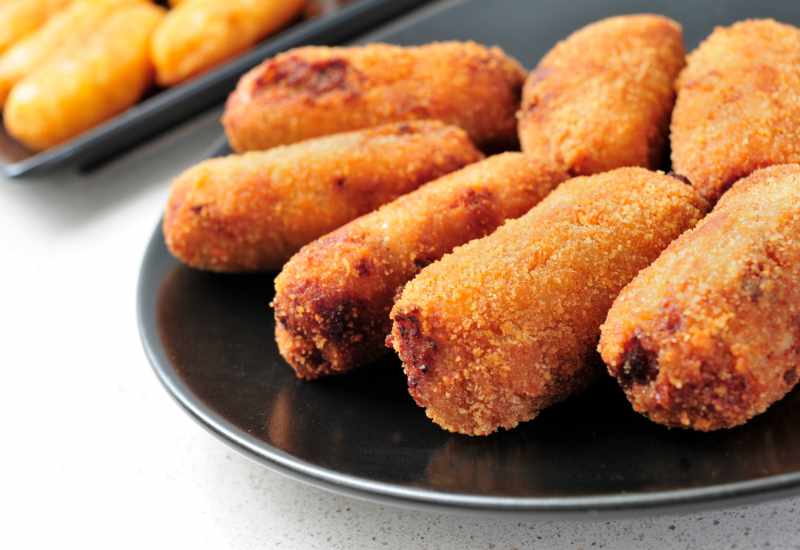
Croquetas de Pollo, or chicken croquettes, is a dish of breaded then deep-fried chicken pieces. To make the croquettes, chicken is first cooked then cut into small pieces and mixed into a bechamel sauce. The mixture is molded into small finger shaped logs which are dipped into eggs then rolled into breadcrumbs and fried.
Croquettes are popular as tapas when sold in restaurants and a staple of Spanish households.
Chicharrón (Fried Pork)
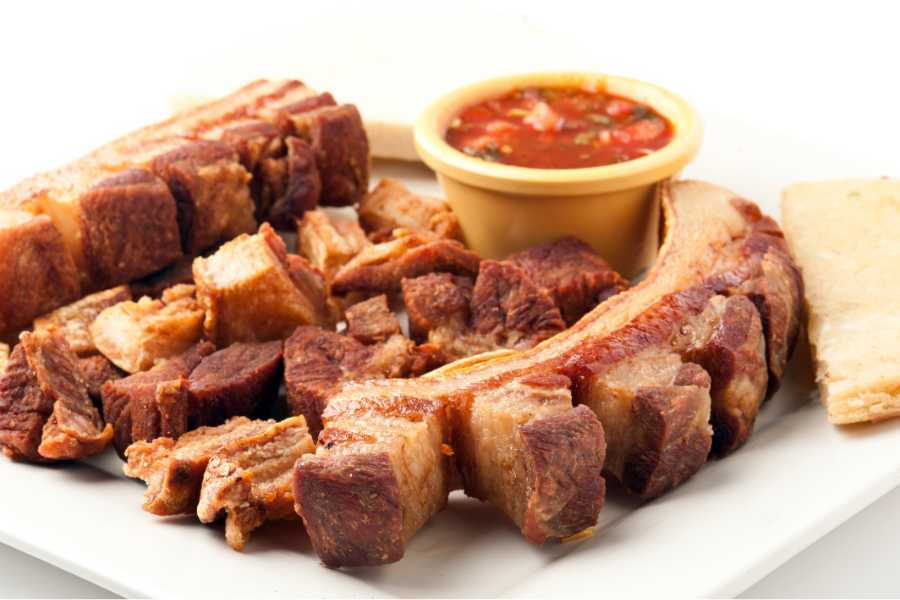
Chicharrón is a pork dish made by frying pieces of pork skin or pork belly until they turn golden brown and crispy. While frying is the traditional and preferred method of cooking, chicharrón can also be made by baking.
Besides being the name of the dish, Chicharrón also means crackling in Spanish.
The plural form is chicharrones. Chicharonnes and pork rinds are the same thing, however chicharonnes can be made from the skins of other meat like beef.
Natillas (Custard Dessert)
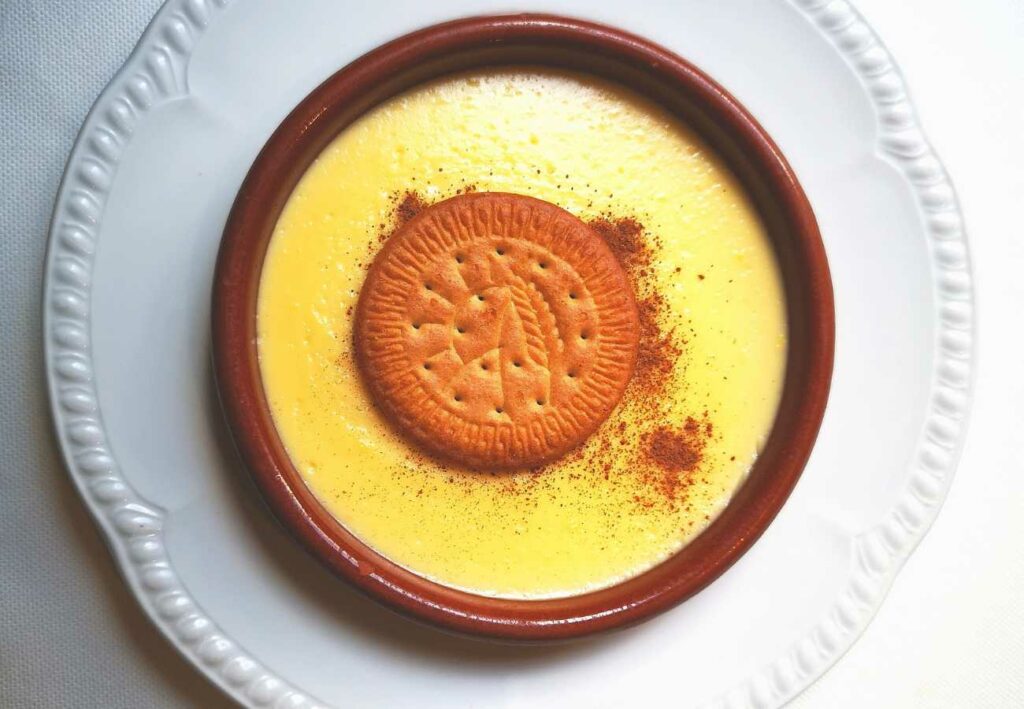
Natillas is a traditional egg custard dessert from Spain which is made by whisking hot milk into an egg and cornstarch mixture which is cooked in a pot until it is thick. After cooking, the custard is chilled for several hours to be served cold, with a Maria biscuit on top.
Bienmesabe (Almond Dessert)
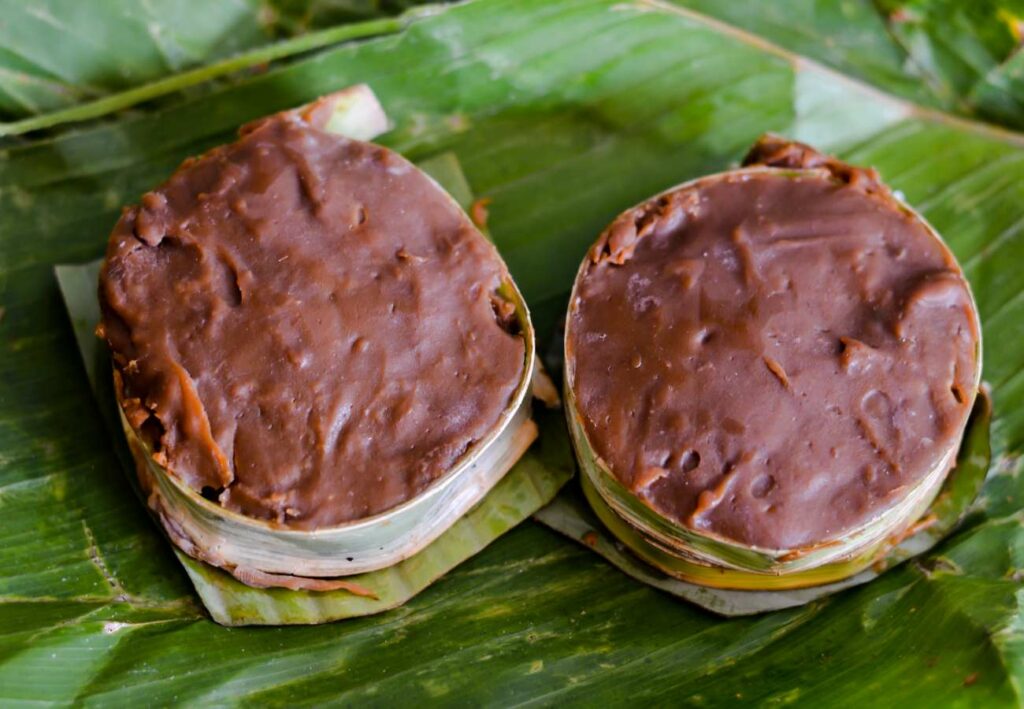
Bienmesabe is a sweet dessert made using ground almonds, egg yolk and honey as its main ingredients. Other ingredients such as cinnamon, lemon zest and sweet wine are also added, depending on the recipe used.
Chocolate Caliente (Chocolate Drink)
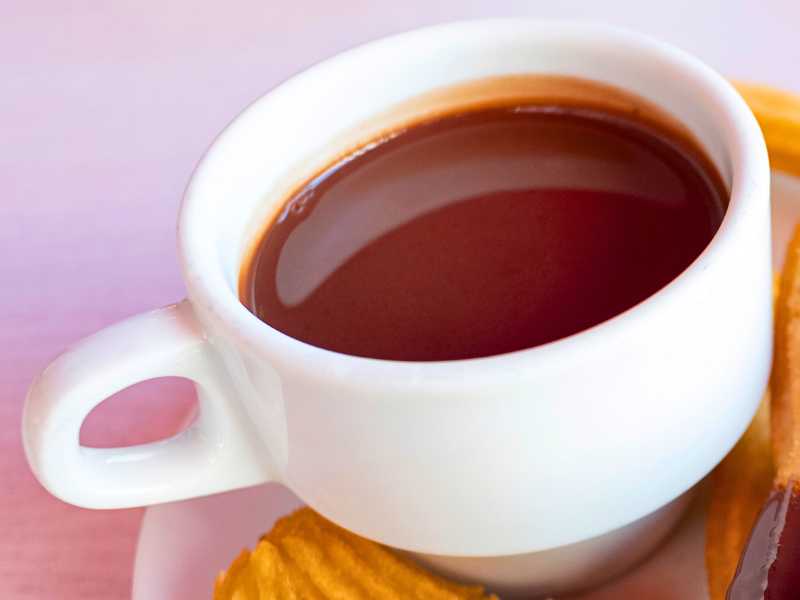
Chocolate Caliente is a hot chocolate drink made using milk, sugar, cornstarch and high quality dark chocolate. The cornstarch and sugar are mixed into the milk until they dissolve. Once both have dissolved, the milk is heated up, the chocolate is added and stirred until it is completely melted.
This chocolate drink is usually served as part of breakfast and is commonly served with churros to dip into.
Magdalenas
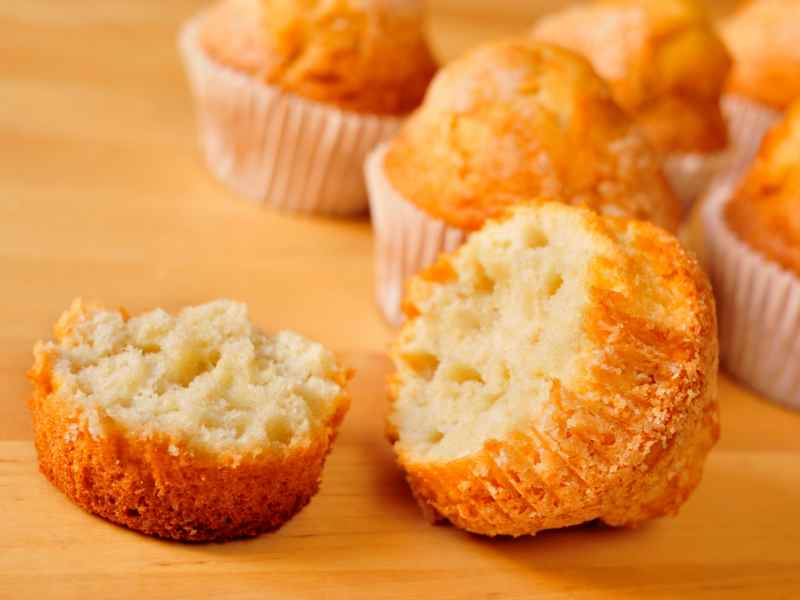
Magdalenas are a type of sponge cake from Spain made with flour, eggs, sugar and baking powder but what makes them unique is the addition of olive oil combined with lemon flavor.
Usually baked in small cake tins, Magdalenas are have the shape and texture of cupcakes or muffins.
Flan de Calabaza
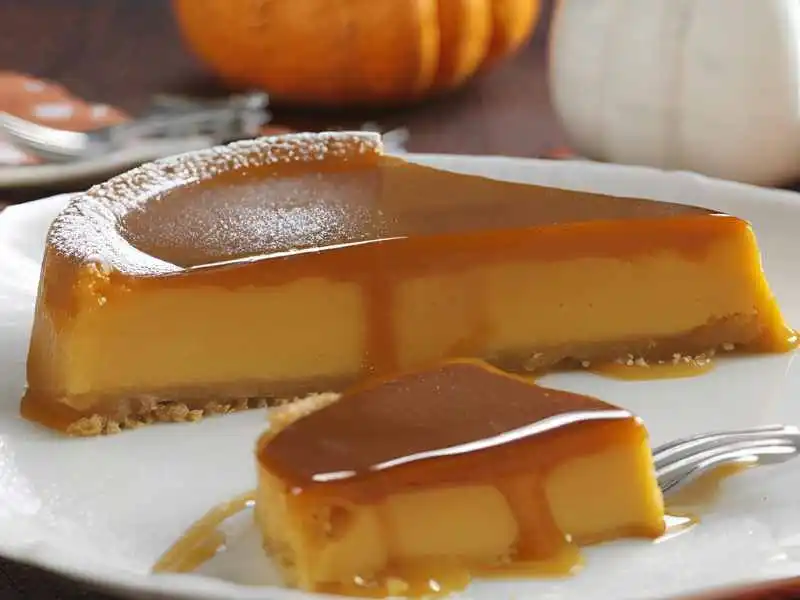
Flan de calabaza is a traditional pumpkin flavored custard dessert made with freshly pureed pumpkin, eggs, sugar, condensed milk, vanilla. The mixture is then poured over a caramel layer and baked.
After baking the flan is cooled then refrigerated for several hours to set. Once set, it is flipped over so that the caramelized layer becomes the top which eventually drip down the sides of the flan.
In the Caribbean Spanish speaking islands including Cuba, ‘calabaza’ means pumpkin or squash even though there are many types. It also refers to a unique butternut squash that grows in Cuba that is preferred for making flan.
Carajillo

A Carajillo is a coffee cocktail from Spain containing liquor, coffee, citrus peel, and cinnamon. The liquor is usually brandy, rum, or mezcal = depending on the country it is served in which it is served. The coffee is strong and it is served without milk and often referred to as a Spanish coffee.
Tecula Mecula
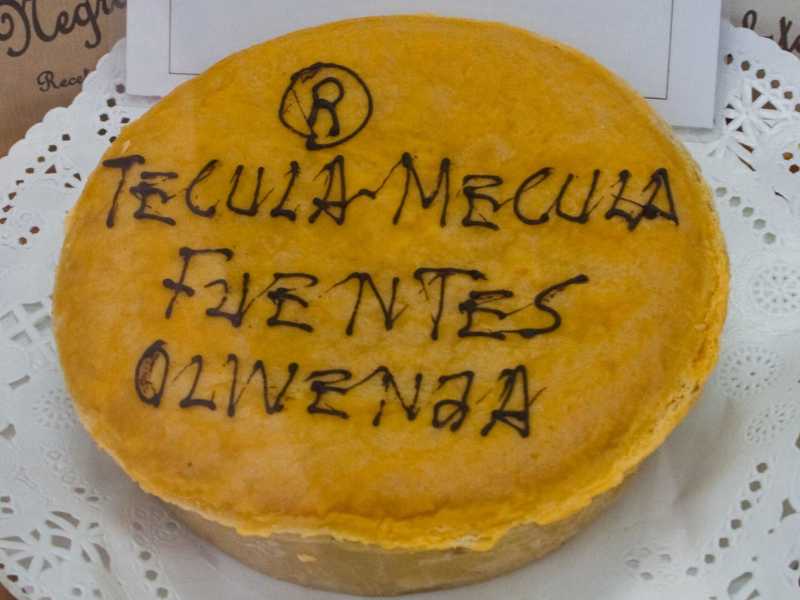
Tecula Mecula is a traditional dessert from Extremadura which consists of eggs and almonds. It is made by mixing the eggs with sugar syrup, then adding the almonds, fat, and a thickener.
This is used as a filling, which is then placed into a dough crust and baked. After it has cooled, the dessert is garnished by writing tecula mecula, in chocolate over the top.

